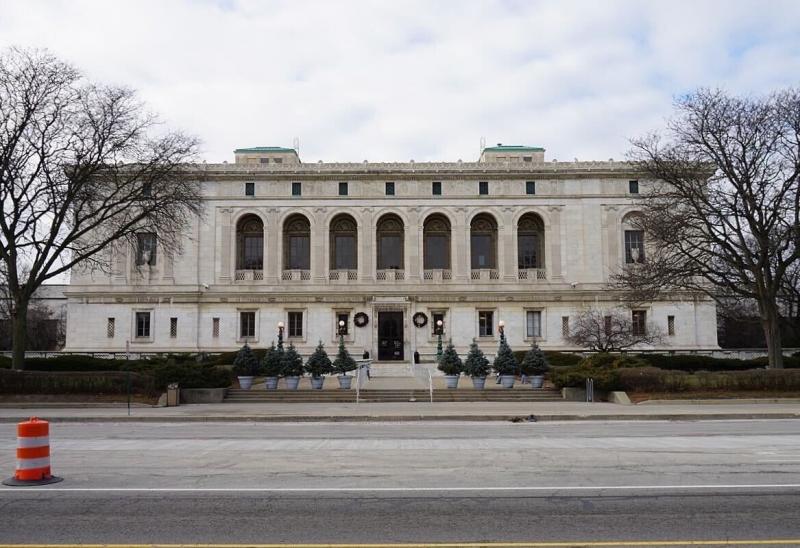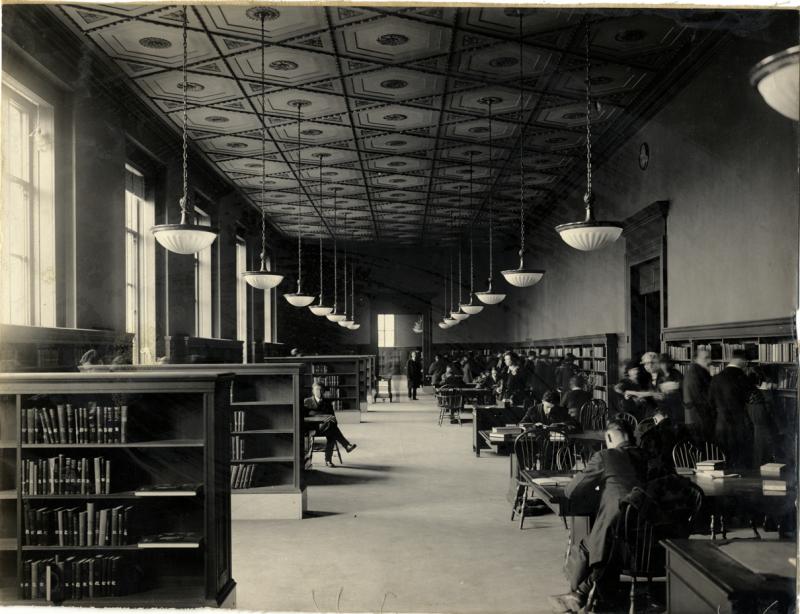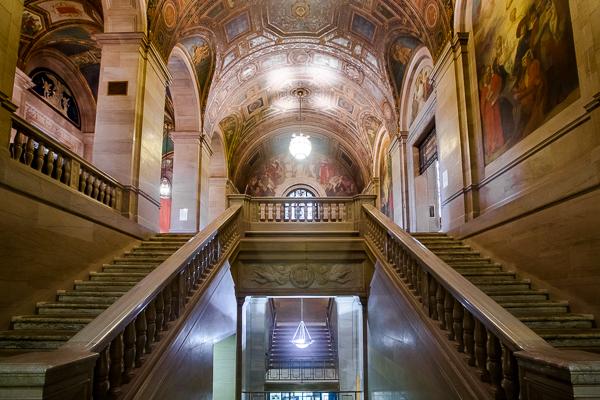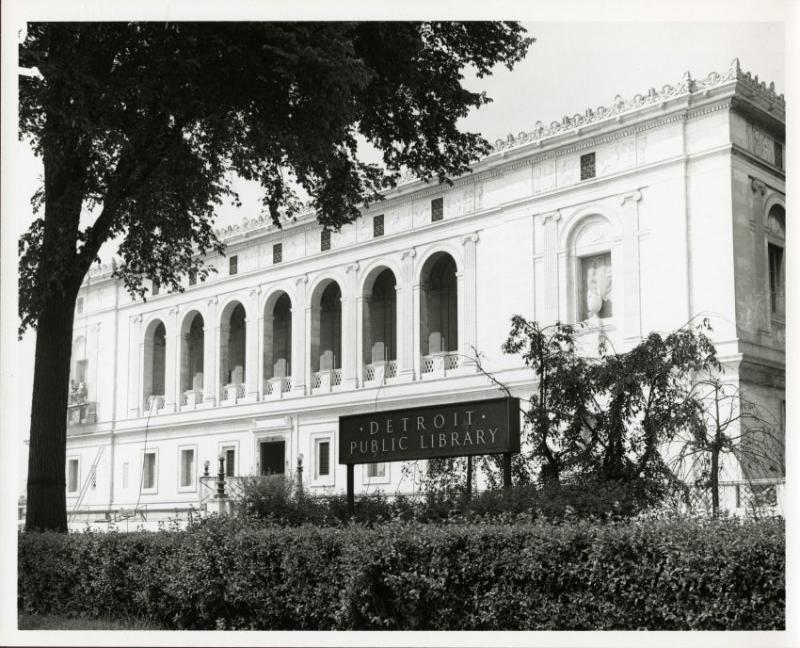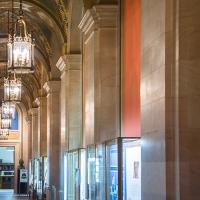-
Name of property current (historical)
-
Detroit Public Library, Main
-
Entry author
-
Chloe (Zihan) Zhang
-
Abstract
-
The main Detroit Public Library building was commissioned by Andrew Carnegie in 1912 as a gift to the city of Detroit. Designed by Cass Gilbert, the library served as a hub for education and cultural enrichment. Andrew Carnegie believed that his donations to public libraries were a way to invest in the future of communities.
The library's Beaux-Arts style of architecture reflects both the culture of the giver, Andrew Carnegie, and the culture of the receiver, the community of Detroit. and that philanthropy plays an important role in promoting social and economic progress. The main Detroit Public Library building serves as a good example of this, as it provided access to knowledge and resources that were crucial for the city's growth and development. Its preservation serves as a reminder of the importance of continuing to promote progress and a sense of responsibility and reciprocity. Its location in Detroit's Cultural Center also reflects the city's growing importance as a center of arts, culture, and industry.
-
Address
-
5201 Woodward Ave, Detroit, MI 48202. (Detroit Public Library, 2023)
-
Architect
-
Cass Gilbert (Detroit Public Library, 2023)
-
Date (comission)
-
1912
"The city commissioned Cass Gilbert in 1912 to construct a three"-floor library in the early Italian Renaissance Style." (Detroit Historical Society, 2023)
-
Date (completion)
-
March 29, 1921.
"...the Main Library finally opened for service on March 29, 1921." (Detroit Public Library, 2023)
-
Program/ function
-
"The Detroit Public Library enhances the quality of life for the diverse and dynamic community in the City of Detroit. The Library enlightens and empowers its citizens to meet their lifelong learning needs through open and equitable access to information, technology, and cultural/educational programs." (Detroit Public Library, 2023)
-
Date (modification, adaptation, renovation)
-
Expansion and Renovation:
"In the 1950s, Detroit's population reached almost 2 million and the library's book collection was over 2.5 million volumes. To accommodate these changes, the Cass Avenue wings opened on June 23, 1963. The expansion added 240,000 square feet to Main, doubling its size." (Detroit Public Library, 2023)
-
Style/ distinct features/ cultural reference
-
Beaux-Arts style architecture.
"Some defining features of Beaux-Arts style architecture are: Focus on symmetry, Hierarchy of interior spaces, Classical details, Including columns and pediments, Highly decorative surfaces, Statues and figures embedded within the façade, Raised first story, Stone or stone-like materials." (Chicago Architecture Center, 2023)
"The library’s structure was constructed with Vermont marble and Serpentine Italian marble. The phrase 'Knowledge is Power' was carved into the marble above the main entrance on Woodward Avenue." (Detroit Historical Society, 2023)
-
Gift giver/ funder/ contributor
-
Andrew Carnegie
"Scottish-born Andrew Carnegie (1835-1919) was an American industrialist who amassed a fortune in the steel industry then became a major philanthropist." (History.com Editors 2009)
-
Beneficiaries and impact on the community
-
The beneficiaries:
“DPL’s goal is to meet the educational, professional, cultural, and recreational needs and interests of its customers, regardless of race, creed, age, language, ethnicity, education, occupation, economic, or social status. To meet this commitment, the DPL collects, organizes and makes information accessible in a variety of formats.” (Detroit Public Library, 2023)
The main Detroit Public Library building has had a significant impact on the community, promoting learning, culture, social engagement, and economic development, and serving as a vital community resource for generations of Detroiters.
-
Was it part of a network of buildings?
-
Yes, the main Detroit Public Library building is part of a network of library buildings that are collectively known as the Detroit Public Library system.
The Detroit Public Library system comprises 23 branch libraries and the main library building, all of which serve the needs and interests of the local community. Each branch library has its own unique character and resources, and they are strategically located throughout the city to provide convenient access to library services and resources for residents in different neighborhoods.
-
Sustainability (financial, cultural)
-
Technology Upgrades: In recent years, the library has implemented a range of technology upgrades to improve its services and accessibility. These upgrades include the installation of computer workstations, free Wi-Fi, and other digital resources.
"The Detroit Public Library expanded its Laptops-to-Go program with an additional 300 circulating laptops and 500 Wi-Fi devices. The items were purchased through federal COVID-19 pandemic relief programs like the Emergency Connectivity Fund and the American Rescue Plan Act." (Fleming 2022)
-
Was the community involved in the process?
-
It is unclear if the community was directly involved in the construction process of the main Detroit Public Library building. However, the library was intended to be a resource for the community and was built with the community's needs in mind.
-
Q1: What were the motivations of the gift-giver and the implications of the gift for the community ?
-
Carnegie's motivation for donating the funds to build the Detroit Public Library, and many other libraries across the United States, was rooted in his belief that libraries were a key resource for promoting social and economic progress. He saw public libraries as a way to empower individuals with knowledge and provide access to educational opportunities that might otherwise be out of reach.
The implications of Carnegie's gift for the community of Detroit were significant. Prior to the construction of the main library building, the city's public library system was relatively small and underfunded, with only a handful of branch libraries serving a population of over 300,000 people. The new main library building, with its vast collections and state-of-the-art facilities, provided a centralized hub for education, research, and cultural enrichment for the entire community.
In addition to the material resources provided by the building, Carnegie's gift had important implications for the labor force of Detroit. The construction of the library building provided much-needed jobs for workers during a time of economic growth and industrial expansion in the city. The building was also designed to be a source of pride for the community and a symbol of Detroit's emergence as a major cultural and economic center.
-
Q2: Was there an imposed sense of responsibility or reciprocation in the case study, and who were the parties that were charged with these actions?
-
Carnegie believed that his donations to public libraries were a way to invest in the future of communities, and he expected the recipients of his gifts to demonstrate a sense of responsibility in maintaining and preserving the buildings he funded. As such, Carnegie often required the local communities to provide a matching contribution to his gift, which would cover the ongoing costs of maintaining and operating the library.
In the case of the main Detroit Public Library building, the community of Detroit was responsible for maintaining and operating the building. This responsibility was overseen by the library board of commissioners, who were appointed by the city government. The board was charged with managing the library's resources, hiring staff, and maintaining the building and its collections.
At the same time, there was also a sense of reciprocation that was expected from the community of Detroit. Carnegie believed that his gifts were a way to promote social and economic progress, and he expected the local community to reciprocate by using the library as a means of improving their own lives and the lives of others around them.
The community of Detroit responded to this expectation by using the library extensively, with hundreds of thousands of residents visiting the main library building and its branches each year.
Overall, the sense of responsibility and reciprocation in the case of the main Detroit Public Library building was shared between the gift-giver, Andrew Carnegie, and the community of Detroit. Both parties were charged with taking care of the building and ensuring that it served as a valuable resource for education and culture.
-
Q3: Do the design characteristics (i.e material, layout, location) reflect either the culture of the giver, the culture of the receiver, or a mixture of both?
-
The design characteristics of the main Detroit Public Library building reflect a mixture of both the culture of the giver, Andrew Carnegie, and the culture of the receiver, the community of Detroit.
The Beaux-Arts style of architecture used in the design of the building was popular in the United States during the late 19th and early 20th centuries, and it was associated with the cultural and intellectual aspirations of the American elite. The style drew inspiration from the classical architecture of ancient Greece and Rome, as well as the Renaissance architecture of Italy and France.
The use of this style in the design of the main Detroit Public Library building reflects the cultural values of Andrew Carnegie and his belief in the importance of education, culture, and civic pride. The grand scale and ornate details of the building convey a sense of importance and significance, and they serve as a symbol of the community's aspirations for progress and prosperity.
At the same time, the location and layout of the building reflect the needs and desires of the community of Detroit. The library was strategically located in the heart of downtown Detroit, making it easily accessible to a large and diverse population. The layout of the building was designed to maximize the use of space and provide a range of services and resources that would be relevant and useful to the community.
In this way, the design characteristics of the main Detroit Public Library building reflect a combination of the cultural values of the giver, Andrew Carnegie, and the receiver, the community of Detroit. The building is a testament to the shared belief in the importance of education and culture.
-
Bibliography
-
Bibliography “About.” n.d. Detroit Public Library. Accessed April 11, 2023. https://detroitpubliclibrary.org/about.Barera, Michael . 2015. The Exterior of the Main Branch of the Detroit Public Library in Detroit, Michigan (United States). Wikimedia Commons. https://commons.wikimedia.org/wiki/File:Detroit_Public_Library_Main_Branch_January_2015.jpg.Chicago Architecture Center. n.d. “Chicago Architecture Center.” Www.architecture.org. Accessed April 24, 2023. https://www.architecture.org/learn/resources/architecture-dictionary/entry/beaux-arts/.Detroit Historical Society. 1975. Black and White Photo of the Woodward Avenue Face of the Main Branch of the Detroit Public Library. Detroit Historical Society. http://detroithistorical.pastperfectonline.com/photo/DE856D60-F2B6-4CB0-8E3E-692993401831.———. n.d. “Detroit Public Library | Detroit Historical Society.” Detroithistorical.org. https://detroithistorical.org/learn/encyclopedia-of-detroit/detroit-public-library.Detroit Public Library. n.d. Detroit Public Library. Accessed April 24, 2023.Fleming, Chandra. 2022. “Detroit Public Library Adds 300 Laptops, 500 Hotspots Available for Checkout.” Detroit Free Press. Detroit Free Press. December 1, 2022. https://www.freep.com/story/news/local/michigan/2022/12/01/detroit-public-library-check-out-laptops-hotspots/69692644007/.History.com Editors. 2009. “Andrew Carnegie.” HISTORY. A&E Television Networks. November 9, 2009. https://www.history.com/topics/19th-century/andrew-carnegie.“Main.” n.d. Detroit Public Library. Accessed April 11, 2023. https://detroitpubliclibrary.org/locations/main.Physical rights are retained by DPL. Copyright is retained in accordance with U.S. copyright laws. n.d. Reading Room on Third Floor, Detroit Public Library. Detroit Public Library. Accessed April 25, 2023. https://digitalcollections.detroitpubliclibrary.org/islandora/object/islandora%3A218015.“Policies | Collection Development.” n.d. Detroit Public Library. Accessed April 24, 2023. https://detroitpubliclibrary.org/policies/collection-development.Shaouni, Marvin . 2015. 7 Wonders of Detroit Public Library’s Main Branch. ModelDMedia. https://www.modeldmedia.com/features/DPL-hidden-treasures-062315.aspx.
